FROM LBCC TO COSTA RICA

WEEKEND CAMPING ON ORCAS ISLAND
How


How
ummer is almost over and fall term is just around the corner. A fresh academic year awaits us full of new opportunities, new faces, and new challenges. I always feel a sense of nervous excitement as fall term approaches; what opportunities does the year have in store for me? What will I learn, how will I grow, who will I meet, and will I do well in my classes? Of course, once the term starts that nervous energy fades away.
The LBCC student body and faculty are an extraordinarily talented community. It’s difficult to be a part of this community and not be inspired, you get swept up in the current of ambitious, driven individuals. I spend a couple of days around this community and the inspiration makes me forget all about my nerves. I want the Commuter to support that energy around campus: to cheer on the students and the faculty, and encourage everyone to strive to be their best selves.
This 2023-24 school year I am taking over as Editor-in-Chief of the Commuter. I’m currently in my second year of the Visual Communications program here at LBCC. I first got involved with the Commuter when I took Principles of Marketing with Rob Priewe, the Commuter Advisor. I worked for the newspaper last year as Marketing Director and I’m overjoyed to have the privilege of working with our award-winning publication again this year
Sas Editor-in-Chief. This year we’ll be releasing a monthly print magazine, which you’re currently reading, accompanied by weekly email newsletters, and plenty of online articles which will be posted to our website. If you’re not able to make it to campus to pick up our magazine, fear not because we’ll be posting digital versions of the magazines to our website as well.
This year, I plan for the Commuter to support the LBCC community by providing engaging content that entertains, informs, and inspires. I’d like to focus on the talent within our student body and our faculty, showcasing what LBCC can accomplish as well as motivating the rest of us in the process. We all have our own backgrounds, our own motivations for coming to LBCC, but we’re all here to learn and grow. The Commuter should be a platform where we can share our stories so that we can learn from one another.
This letter wouldn’t be complete if I didn’t give a big shout out to the amazing Leah Biesack, the previous Editor-in-Chief who led the way as the Commuter transitioned from a mostly online newspaper to a full-color print magazine format. Last year, under Leah’s leadership, the Commuter was the winner of 23 awards, including seven first-place awards, in the 2023 Collegiate Newspaper Contest sponsored by the Oregon Newspaper Publishers Association. With the team of outstanding individuals we currently have working with the Commuter, I don’t have any doubts that we can make some more award-winning content again this year.
The Commuter team and I are looking forward to providing the LBCC community with engaging and inspiring content this year. I hope you find something that resonates with you in these pages.
Ryan Janowitz Editor-in-Chief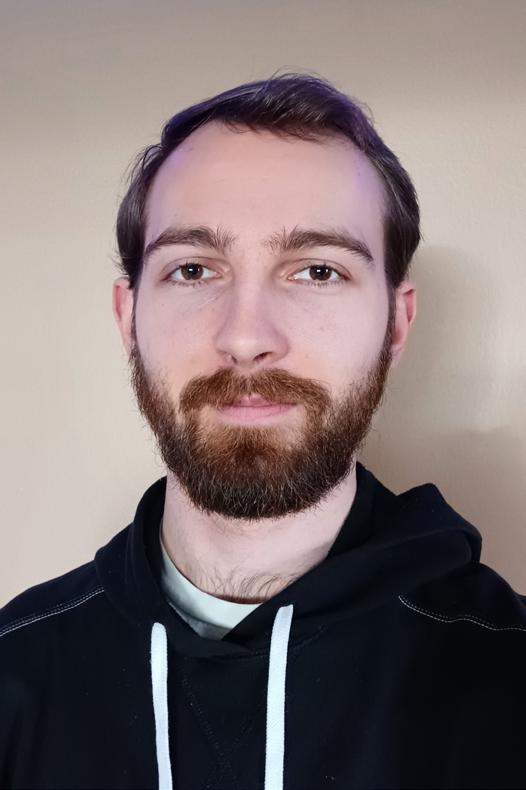
the Commuter is the student-run magazine for LBCC, financed by student fees and advertising. Opinions expressed in The Commuter do not necessarily reflect those of the LBCC administration, faculty and students of LBCC. Editorials, columns, letters, and cartoons reflect the opinions of the authors. LBCC is an equal opportunity educator and employer.
The Commuter encourages readers to use its “Opinion” section to express their views on campus, community, regional and national issues. The Commuter attempts to print all submissions received, but reserves the right to edit for grammar, length, libel, privacy concerns and taste. Opinions expressed by letter submitters do not represent the views of the Commuter staff or the College.
wanna get together? We’re really nice and fairly cool and we’d love to hear what you have to say. Not big on journalism but love to journal? Perfect. Are you a STEM major with major opinions? Let’s hear ’em. Like writing about ’80s film? Local animals? Snack hacks? Maybe you have a hefty folder of flash fiction on your laptop, just dying to be published and printed. Drop us a line. We’d love to meet you, read you, and support you. Think your ideas might be too weird or too niche for submission? Even better. The Commuter is an award-winning publication because of our wide range of contributions and our unique contributors. So reach out. We’ll be staring at our email inbox in the meantime, not an ounce of chill to be had.
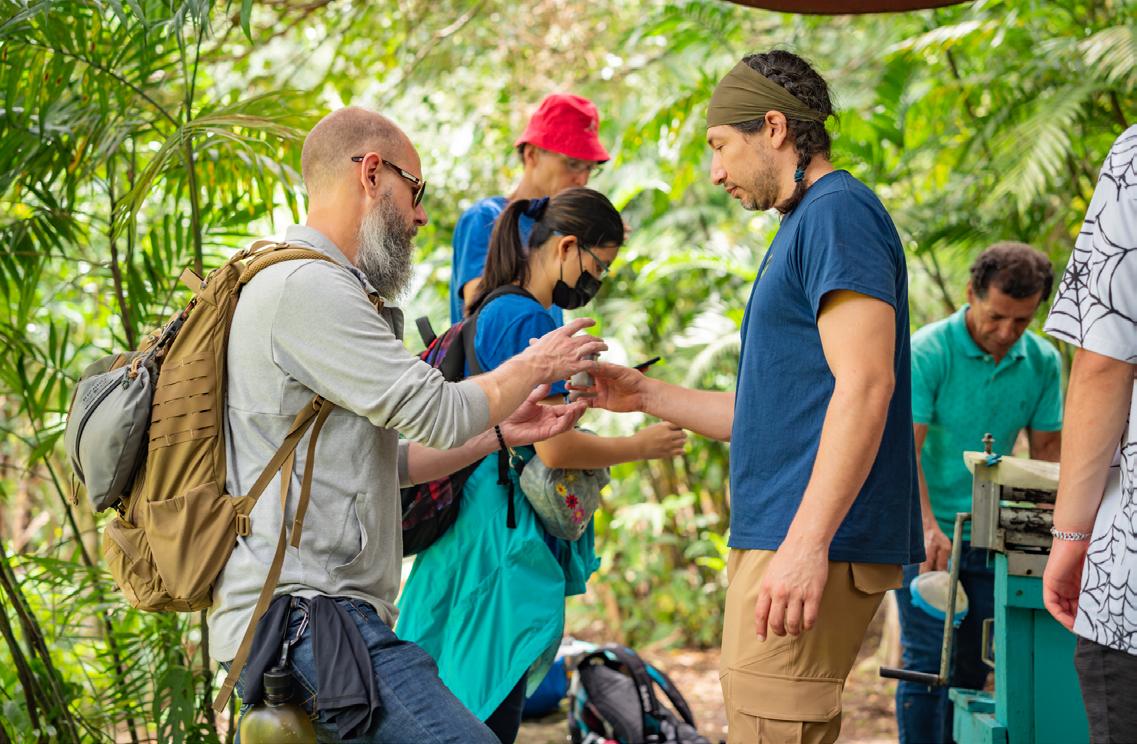
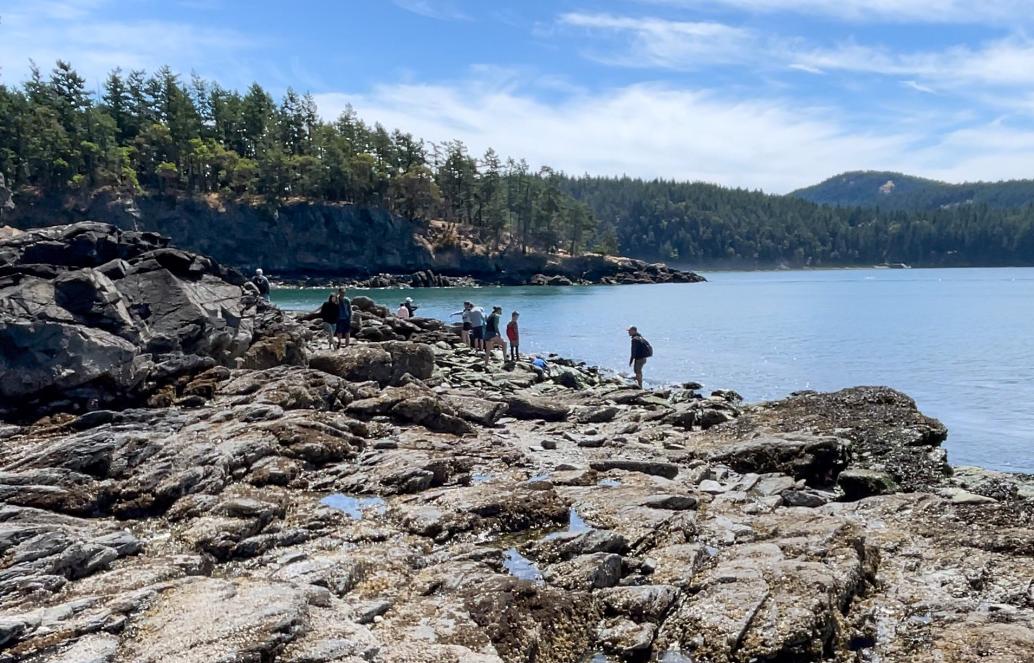

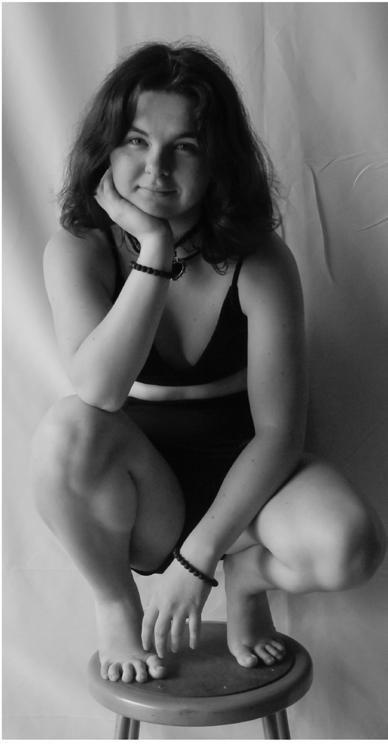

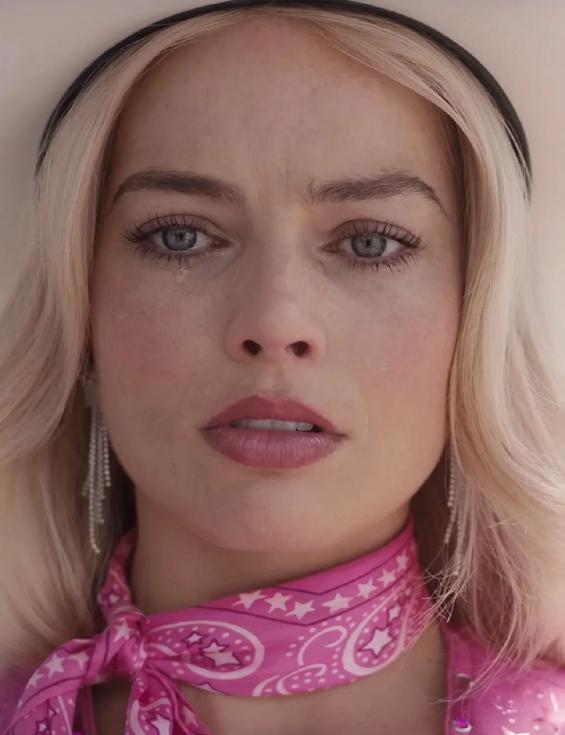
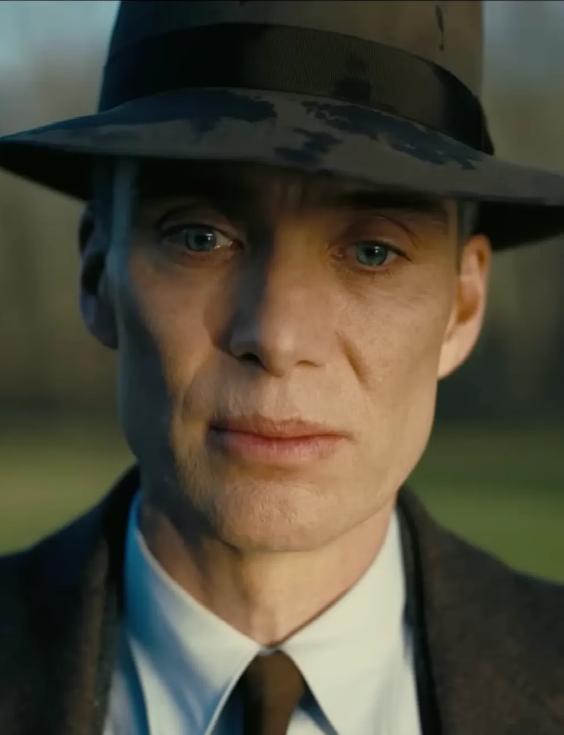
On June 23 a team of 10 participants and two faculty embarked on an adventure to Costa Rica. While there, students attended the Monteverde Institute in Monteverde, Costa Rica — The Cloud City — earning college credit for Spanish language study and literature while they studied stories written by Costa Rican writers.
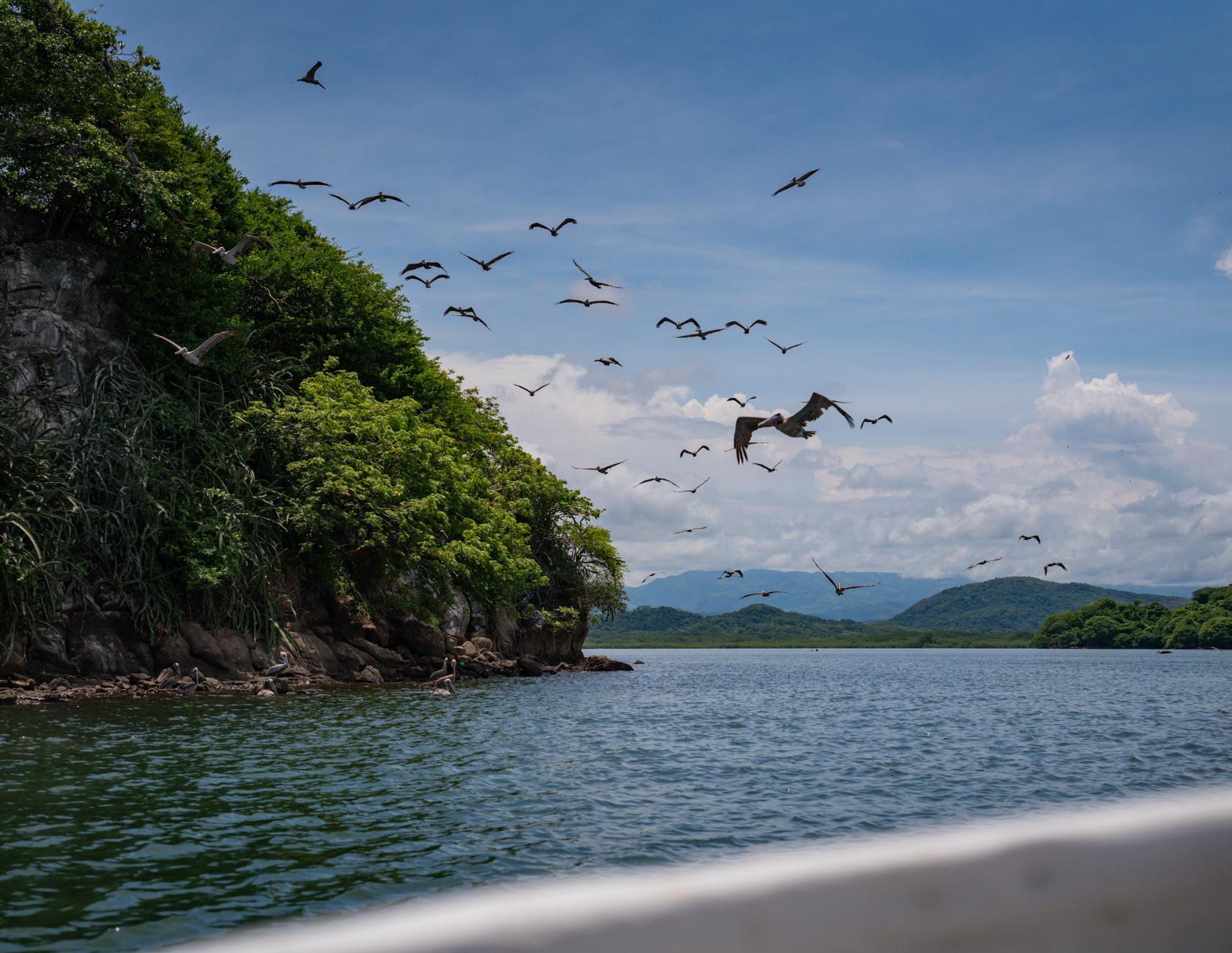
The team started out with a red-eye flight out of PDX on June 23, arriving in San Jose, Costa Rica around 10:30 a.m. on June 24. After passing customs and changing into shorts for the 74-degree weather, the team met up with their coordinator from the institute, Paola Rojas. Rojas worked with the team throughout their stay, ensuring everything went smoothly and everyone had what they needed.
Rojas and the team headed to lunch, followed up by a trip to the University of Peace tucked into the hills of San José. Once there, the team got a tour of the grounds and met with Ariela Fernandez, who serves as the Secretary of the Council Director at UP. Fernandez gave a presentation and answered questions about
peacebuilding, conflict throughout the world, and the history of peace in demilitarized Costa Rica.
Upon leaving UP, the team headed to their hotel for their first night in San José, where many took naps before a three-course dinner hosted by Rojas at the hotel. During dinner Rojas went over the schedule, what to expect, and safety while in Costa Rica. The team then was left to rest up for an early breakfast and tour of the market in San José.
On June 25 the team woke up early. After enjoying breakfast at the hotel, the 10 participants in the LBCC Study Abroad program and their two lead faculty went on a walking and shopping tour of San José led by their Monteverde coordinator, Paola Rojas.
The bus dropped everyone off at Paso De La Vaca to shop at Mercado Central de San José. Here, they learned more about the capital city. The team also learned important lessons from Rojas on how to be a pedestrian in Costa Rica, where pedestrians do not have the right of way.
While on their tour, the team obtained colón (Costa Rican currency). When passing the Teatro Nacional de Costa Rica (The National Theatre of San José), the team wished they could go inside. After Rojas spoke with security, the team was allowed to enter the first salon to view the sculptures on exhibit.

Afterward, the team started their journey to their home for the next two weeks — Monteverde, the home of the Monteverde Institute. MVI is where participants in the program had class each day. The roads in Costa Rica are typically not smooth straight lines. Instead they curve and are sprinkled with potholes. Though the entire country of Costa Rica is slightly smaller than the state of West Virginia, it takes awhile to get from place to place. The drive to Monteverde took a little over two hours.
Along the way, Rojas brought the team to Restaurante El Jardín in San Ramón for lunch. After lunch, they wandered the grounds and viewed the livestock living on the restaurant grounds.

Once at Monteverde, the team met with Elena González to learn about the sustainability practices at MVI. A large focus at MVI is using less than is taken and breaking down waste so it can return to the Earth with a smaller impact. With the importance of helping in the kitchen and not touching the buttons on the showerhead fresh in their minds, the team loaded into the van with Rojas and Matarita to go meet their host families.
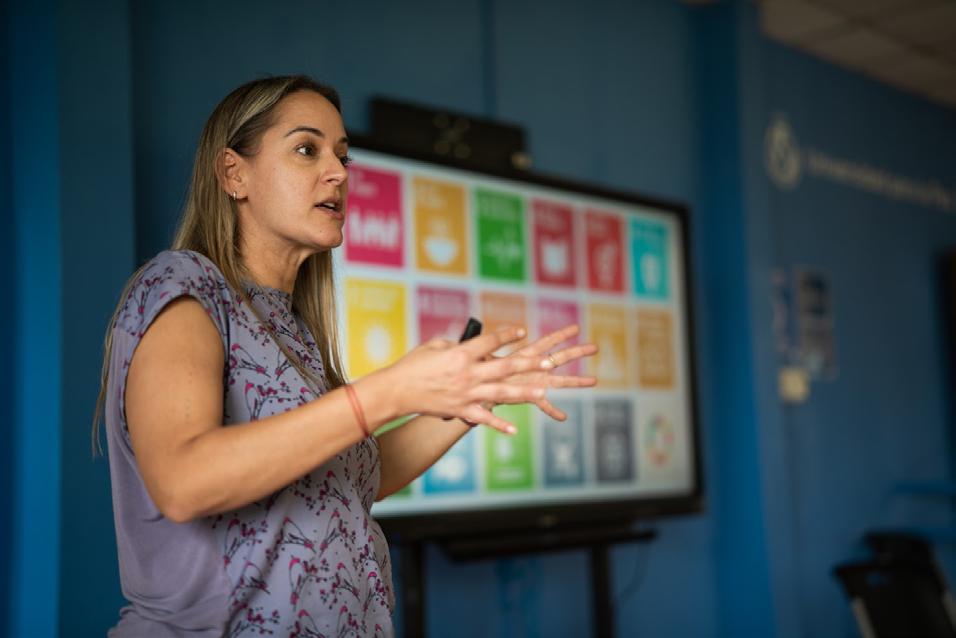
It was then the nerves set in. The van buzzed with excitement as team members shared their greatest fears: language barriers, unknown cultural differences, and how toilet paper is not flushed being among them. As each participant took their bags and went with Matarrita to meet their host moms, the windows of the van
would open for everyone to cheer them on. As one of the famous Monteverde sunsets lit up the Cloud Forest, each participant was shown the meeting spot for them and those who lived close to them (their pod) and waved goodbye to their friends.
Soon after the last was dropped off, the team’s WhatsApp text thread blew up with updates. How quickly they felt at home, how much English was or was not spoken, and pictures of pets already adopting their new family member.
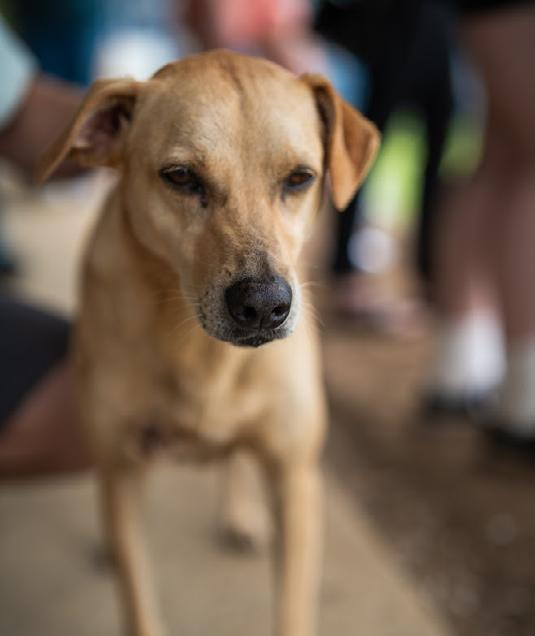
One of the key things Matarita mentioned in homestay orientation was how, though becoming acclimated to the homestay could be difficult, saying goodbye at the end would be even harder. These new faces became like family in just two weeks.
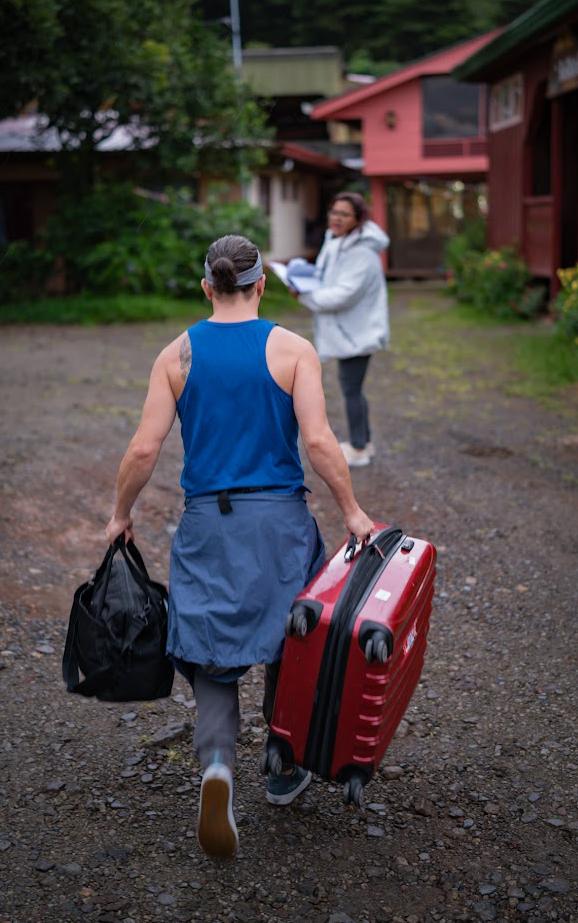

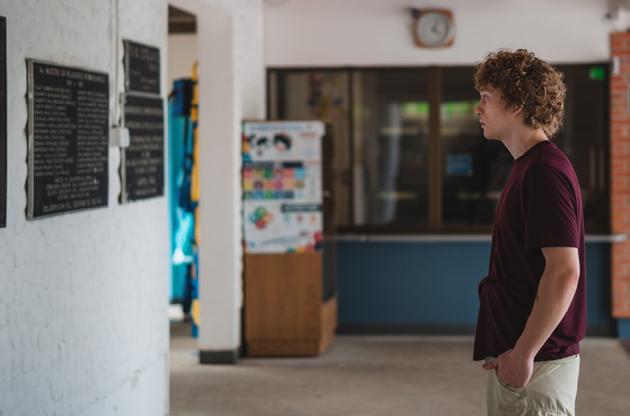
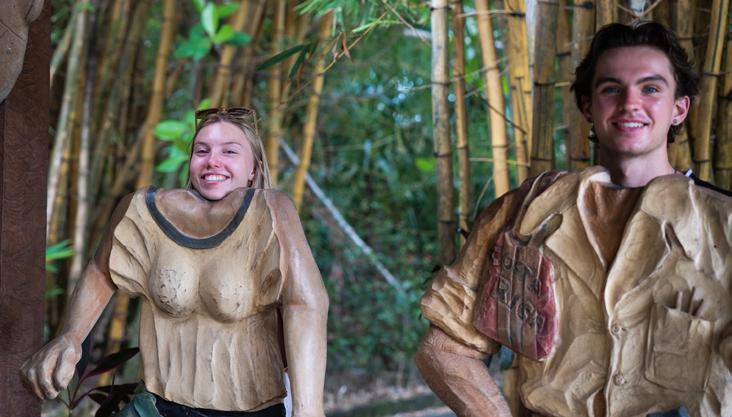
On June 27 the team found themselves in unfamiliar rooms and homes scattered around Monteverde and Santa Elena. Each was greeted by their new host families and sat down for true Spanish immersion over breakfast. Most homes nearly exclusively speak Spanish. The members of the LBCC Costa Rica Study Abroad team are in varying levels of Spanish study, yet all were immersed in the language. With Sunday being their free day, participants found various activities to occupy their time; some traveling with their host families while others explored Santa Elena.
In Santa Elena, dogs run free. Monteverde Institute Coordinator Paola Rojas said that all the dogs have homes, they just enjoy following anyone who pets them. Santa Elena is also home to many souvenir shops and the Cloud Forest attracts lots of tourists. Overall, Costa Rica is well-traveled, with nearly 2.4 million international tourists visiting Costa Rica in 2022. Tourism is the
largest industry in the country and its main source of hard currency.

Costa Rica, being such a small country with so much travel in and out from non-natives, faces challenges for conservation. Despite this, Costa Rica is known for being one of the most sustainable countries in the world. Costa Rica is 98% free of deforestation, creates 93% of its electricity from renewable resources, and conserves around 30% of its territory.
Monday came and the participants were met at each of the checkpoints near their homes to begin a walking tour with Rojas. As they went, Rojas took them to Café Zuccaro, a bakery and coffee shop she works at in addition to MVI. Coffee is a main staple of Costa Rica, and while everyone was served coffee by their host families, the chance to grab a second cup at Café Zuccaro along with a pastry sounded great to participants.
From the furthest homestay, it was about a one-hour walk; the closest being around five minutes. The walk into the Cloud Forest, however, is beautiful. As Rojas led them through, they passed Santa Elena and up the hillside where, on a clear day, you can see the Gulf of Nicoya. Most days, depending on the schedule, the participants could choose to walk or catch a bus to school, and at the end of the day they could opt to purchase a shuttle home. Everyone agreed that would be a great choice on days with torrential downpours.
Upon arriving at the institute, the team was greeted by the MVI staff and cups of fresh fruit. The team then met with Elena González to learn more about the sustainability practices at MVI, from natural greywater filtration to reforestation projects.
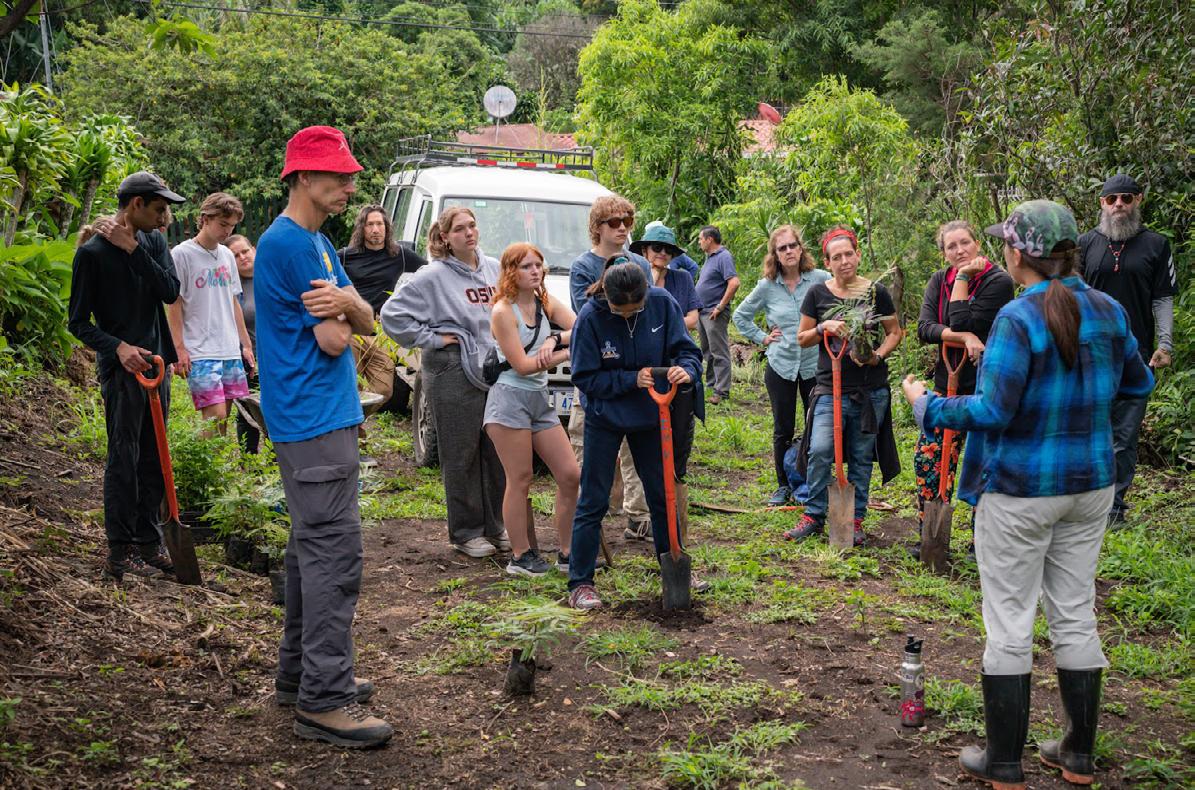
While at MVI, the study abroad team had the opportunity to learn more about the economy, values, culture, and landscape of Costa Rica. Organized by the institute and led by Rojas, the team took advantage of the warm sunny mornings to explore. At the same time, the rainy afternoons were spent in Spanish and Costa Rican literature classes.
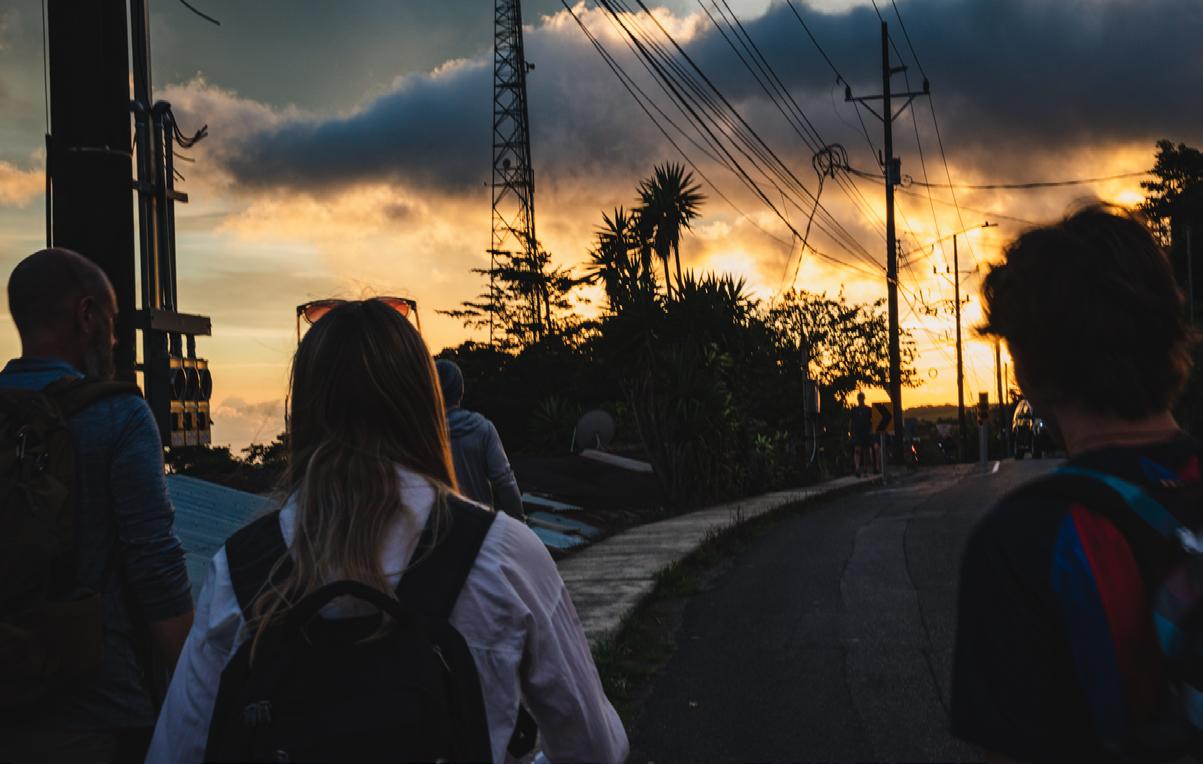
For the last few days with their host families, the study abroad team settled comfortably into their Tico life. On July 6, the group woke up early for a bird-watching hike with Olman Sisneros into the Curi-Cancha Reserve in Monteverde. Sisneros has spent most of his life tracking native wild birds in the area and was quick to spot any within earshot. Among the birds the team observed were toucanets and the famous bellbird, with its distinct loud call and three waddles hanging beside its beak like a mustache. Other activities included dance classes, where students learned to salsa, merengue, and cumbia; a Costa Rican cooking class, and an opportunity to participate in a reforestation project providing habitat for the diverse community organisms. Sustainability is not a practice in Costa Rica, it is a way of life.
Costa Rica is a country whose mission is to leave the smallest human imprint possible. Ticos work to create systems that reduce the impact of waste, industry, and pollution on the environment. Throughout their time in Costa Rica, the study abroad team encountered this value system, whether they were planting trees in the forest or recycling organic material in one of the many bins at the school dedicated to low-impact disposal. They learned about
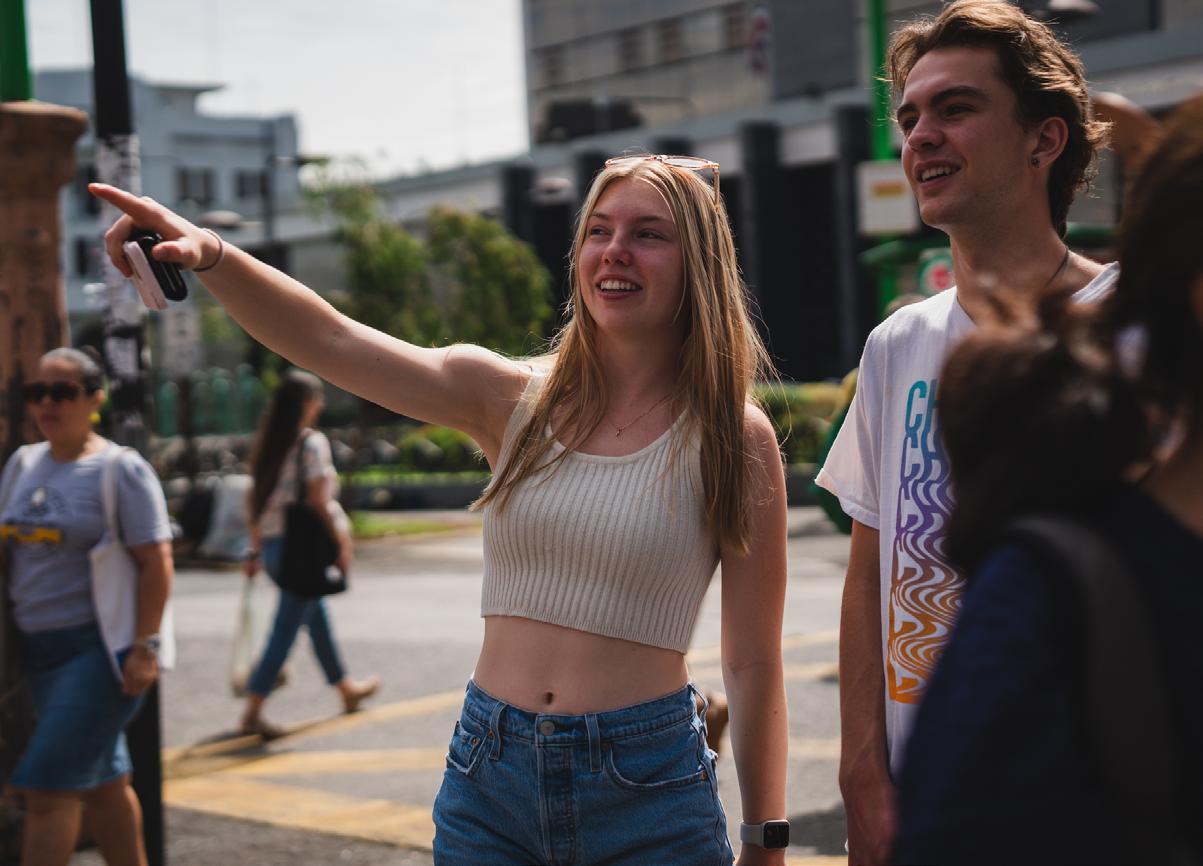
Wilford “Wolf” Guindon, a chainsaw salesman who, in the early 1950s, settled in Monteverde with the Quakers. Giving up his chainsaws, Guindon went on to be one of the most well-known conservationists in Costa Rica.
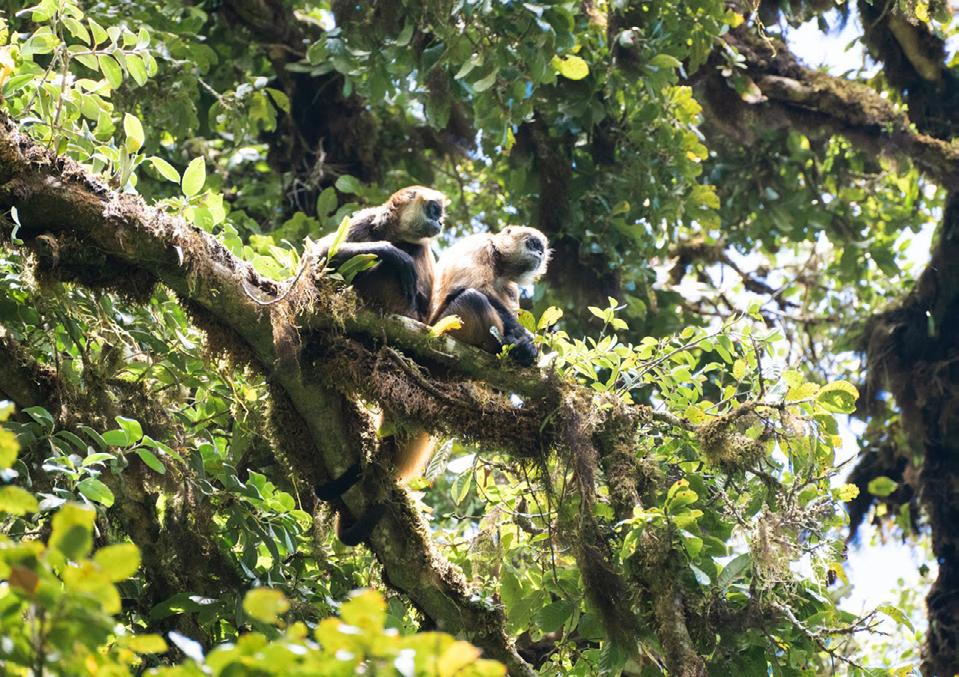
Each night, team members sat around the dinner table with their host family discussing ecology, the use of pesticides in farming and fishing, the trade-off of convenience for sustainability, the military complex, war and peace, as well as the part that government opinion and policy play for environmental impact. This along with discussion over a host mom’s new haircut, similar video game tastes, Bigfoot, and lots of laughter. For many, these conversations were all or mostly in Spanish.
In their Costa Rican literature class led by LBCC Dean Meg Roland, the team learned about the history of poverty and inequality in Costa Rica as well as the deep connection the Tico have with the Earth. This was evident in the writings of Costa Ricans from various regions, as well as through digging deeply into Costa Rican poetry. Within their Spanish classes, students used their Spanish language skills while attempting to explain Amazon deliveries in the US to their Tico teachers and discuss the popularity of single-use plastics.
Another key topic of discussion was peace in Costa Rica and the need for peace in the rest of the world. Costa Rica became a demilitarized country in 1948, allowing the military budget to go towards education, the country’s security, and culture. The concept of peace is now just as deeply rooted in Costa Rican life as recycling. The conversation of peace-making began with the first day’s visit to University for Peace and carried through the rest of the team’s time in the country.
Two weeks in Costa Rica proved to be far more expansive than the team had originally expected. While there, they learned what peacebuilding is from The Peace University, discovered the vast ecosystem in the forest and at the ocean, learned to dance,
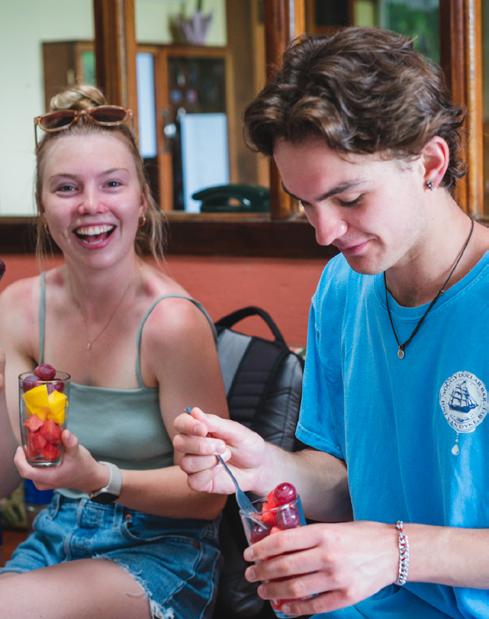

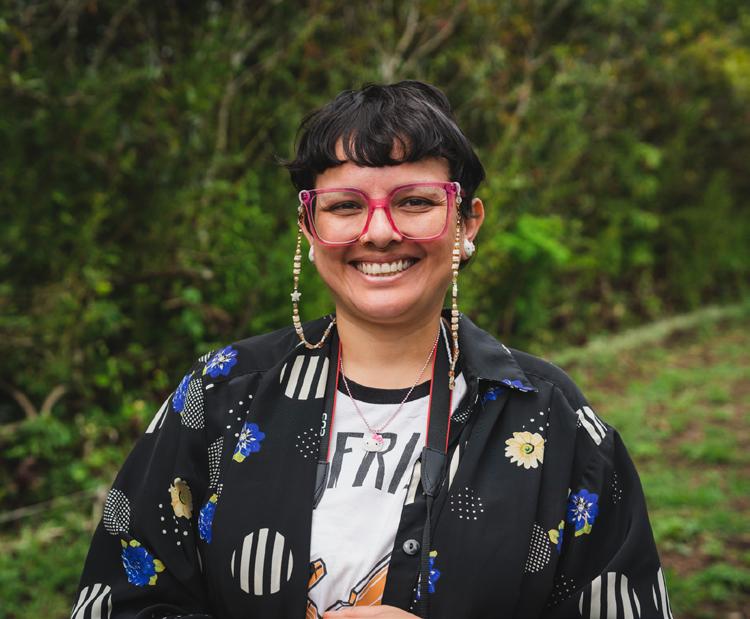

learned to cook, and were fully immersed in their homes, in the town, and at school with Spanish language. They understood the country through the words of literary authors and poets and learned of more ways to leave less of a footprint on the Earth.
The team also became a part of Tico families and grew close to one another. On July 8 the study abroad team packed up their bedrooms and met their host families at a special lunch. During lunch, each participant gave a presentation. Some read poetry in Spanish, some of which they had written themselves. Some sang songs of thanks, and Ralph Tadday offered the custom-painted LBCC soccer ball he had brought. The team used this ball in their Tico vs. US fútbol game.
The last moment with their host families arrived. With tearful hugs and promises to return, the study abroad team boarded a van that took them back to San José. The only goodbyes left would be at the airport the next day to their fearless leader Rojas, and then to each other, knowing that they would each return to their regular lives. In the trip’s 17 days, the team spent more time together than apart.
Opting out of transportation so they could spend time walking with each other, the team walked some four miles to school and home every day. In the words of The Beatles, “Though I remember I’ll never lose affection for people and things that went before, I know I’ll often stop and think about them.”
Leaving their new loved ones and their Tico lives behind, the study abroad team returned to the United States forever to remember their time in Costa Rica.
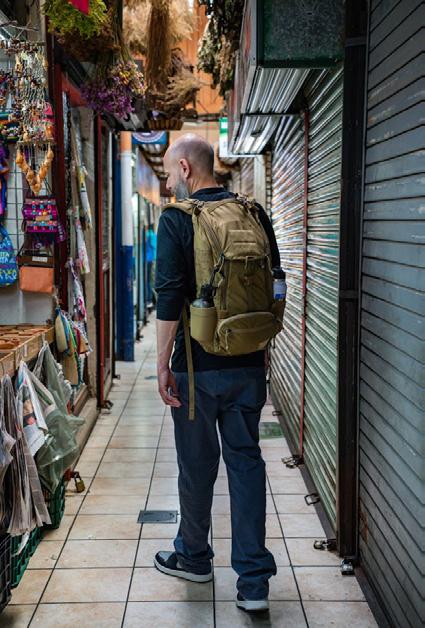

LBCC faculty hope to offer more study abroad trips like this one in the future. Keep an eye out for informational meetings in the 2023-24 academic year.
For more photos from this trip, visit lbcommuter.com
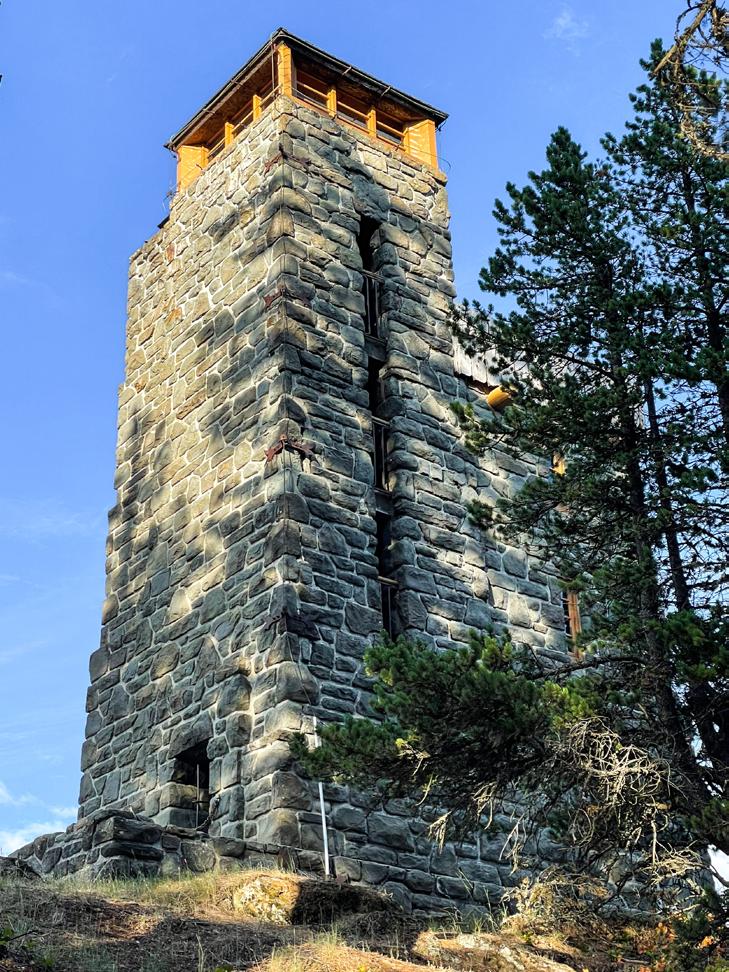
in the stunning San Juan archipelago of Washington State, Orcas Island beckons travelers seeking a tranquil escape into nature’s embrace. With its lush forests, serene landscapes, and diverse wildlife, this picturesque island offers a myriad of experiences to satisfy every adventurer’s soul. Whether you’re a nature enthusiast, a water sports lover, art aficionado, or just looking for a “latitude adjustment,” Orcas Island has something special to offer.
A view of East Sound Bay from the walking path in Eastsound. Orcas Island’s charming downtown bustles with fun activities.
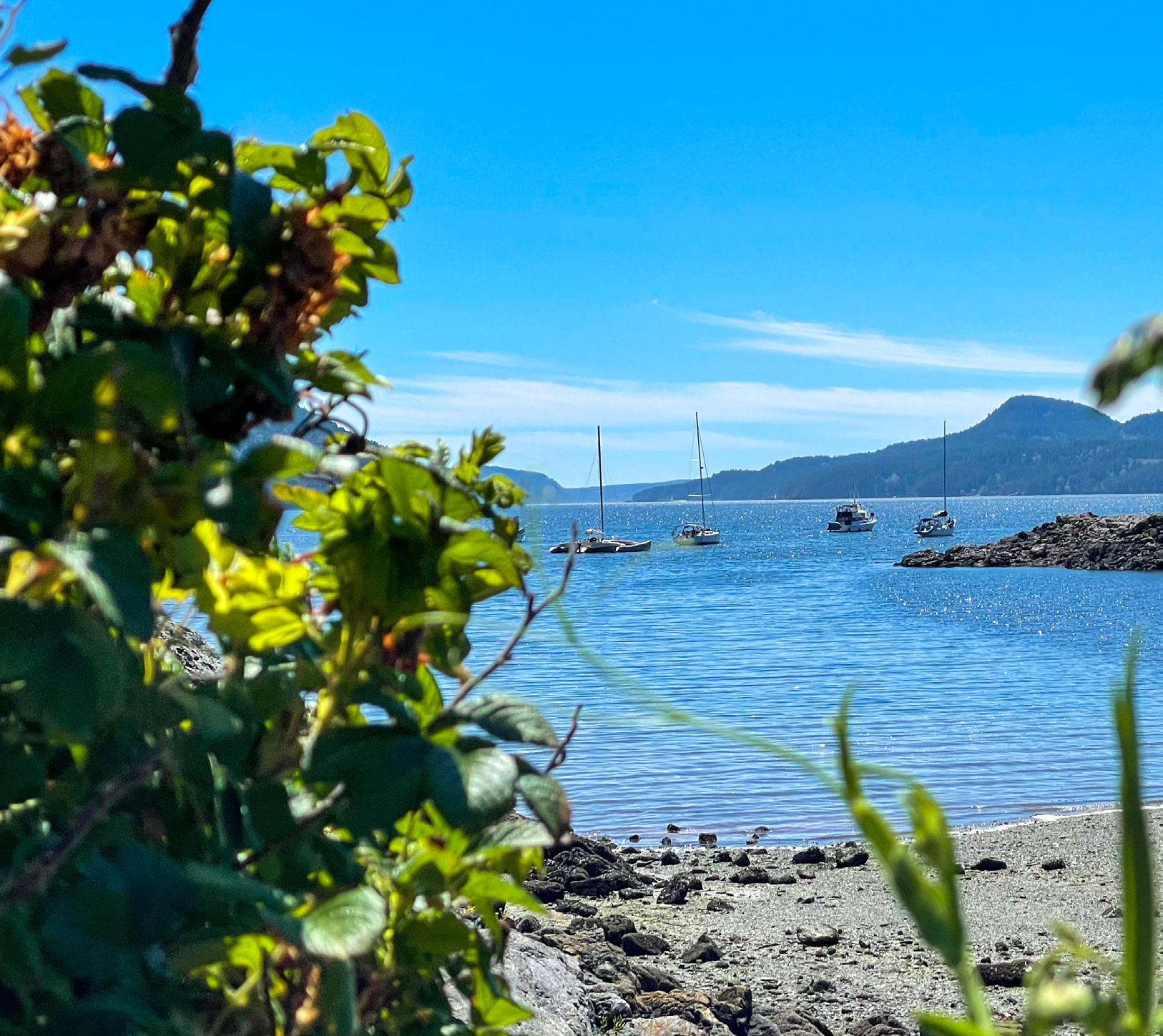
Trail markers at Cascade Falls trailhead mark the way for hikers. More hiking trails can be found at visitsanjuans.com
Getting to Orcas Island requires taking a ferry from Anacortes (reservations can be made via wsdot.com), or by plane. If you’re taking a car over on the ferry, book reservations as early as possible as they fill up quickly. You must arrive at least 30-minutes before the scheduled departure or you’ll lose your reservation.
Tip: If you’re coming from the south, make sure you leave a good time buffer for traffic in Tacoma and Seattle so you don’t miss your reservation. I left a two-hour buffer and still made it seven minutes late. Luckily there was a standby spot available.
Once you’re on the island the fun can begin! Here are some of the best things to do on Orcas Island to discover why it’s a must-visit destination for nature lovers and wanderers alike.
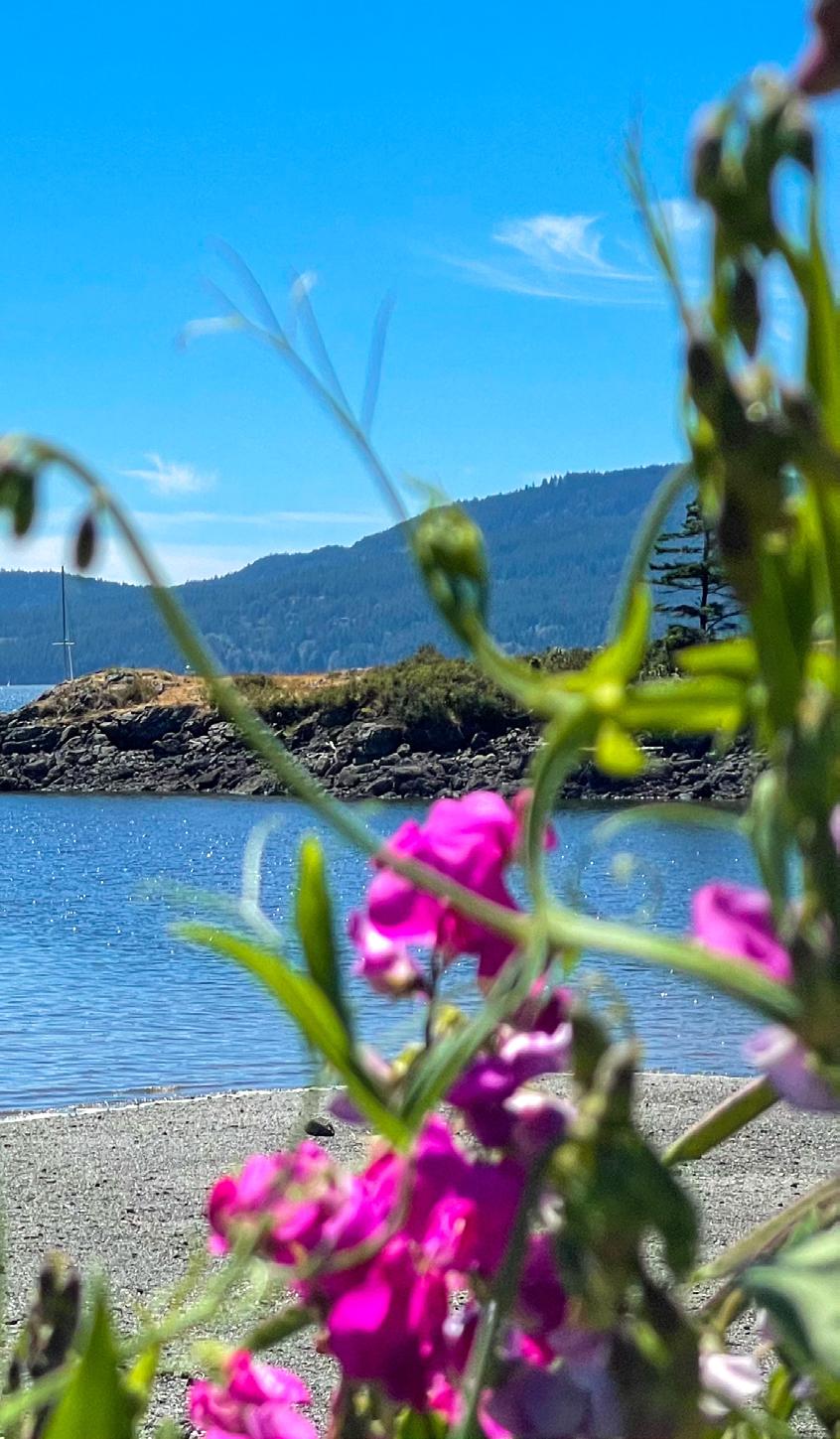
One of the best things about Orcas Island is that it’s a great place to reconnect with nature. And what better way to get really connected with the great outdoors than to live in it for a few days! Moran State Park is one of the most popular places on the island to camp. It has 124 standard campsites and 6 hiker/biker sites spread across four campgrounds. If you’re looking for a more glamorous camping experience, LEANTO, also located within Moran State Park, offers walk-in platform tents with everything but the bedding included. If you’d rather skip camping altogether, the island is full of hotels, inns and resorts to stay in.
For nature lovers and hikers, a visit to Moran State Park is a must. With over 5,000 acres of pristine wilderness, it’s a playground
for outdoor enthusiasts.
Cascade Lake within the park is a great place to cool off and enjoy a day of swimming and picnicking. This idyllic lake offers a refreshing oasis surrounded by lush forest and breathtaking scenery. If you didn’t bring your own, you can rent a kayak or paddleboard to explore the tranquil waters or simply relax on the shore with a good book. The water is also a lot warmer than many other lakes in the PNW, so it’s a nice treat to swim in!
The park is full of beautiful hikes including: Mount Constitution Trail: Arguably the most popular hike in the park, the Mount Constitution Trail leads to the summit of Mount Constitution, the highest point in the San Juan Islands. The trail is approximately 6 miles round trip and offers stunning views of the surrounding islands, the Salish Sea, and even the distant Cascade and Olympic Mountains on clear days. At the summit, you’ll find the historic stone observation tower, offering breathtaking panoramic views.
Cascade Falls Trail: This family-friendly hike is a shorter and easier option, perfect for all ages and skill levels. The trail is around 1.6 miles round trip and leads to the picturesque Cascade Falls. The waterfall, nestled in a lush
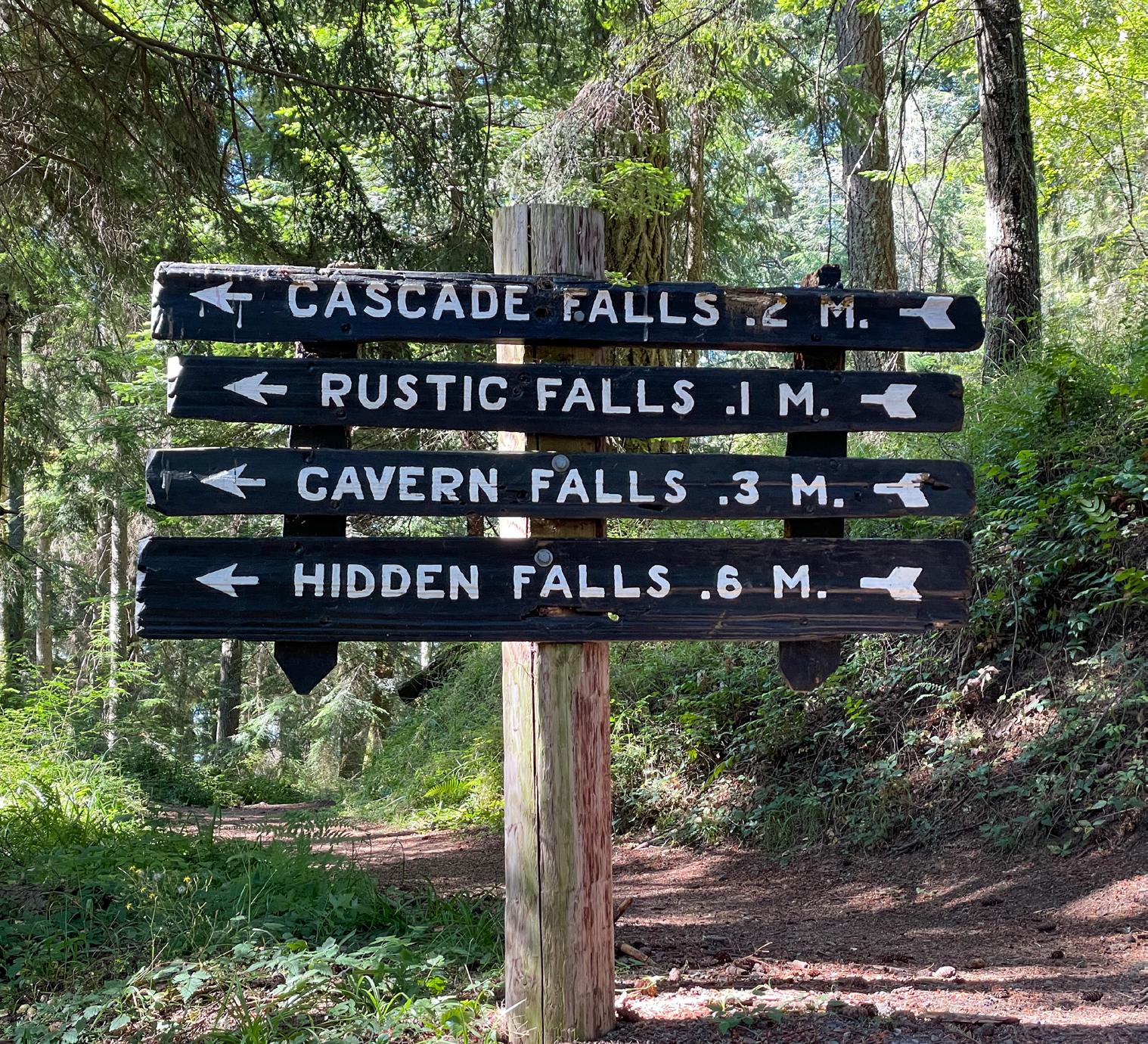
forest setting, is particularly beautiful after rainfall or during the spring when the water flow is at its peak. Hiking up the trail in the opposite direction for a little more than a mile round trip, will take you to three additional waterfalls: Rustic Falls, Cavern Falls and Hidden Falls. This was my favorite trail on Orcas Island and definitely worth the trip.
Mountain Lake Loop Trail: The Mountain Lake Loop Trail is a 4-mile loop that meanders through enchanting old-growth forests and offers picturesque views of Mountain Lake. The trail provides an opportunity to spot various wildlife.
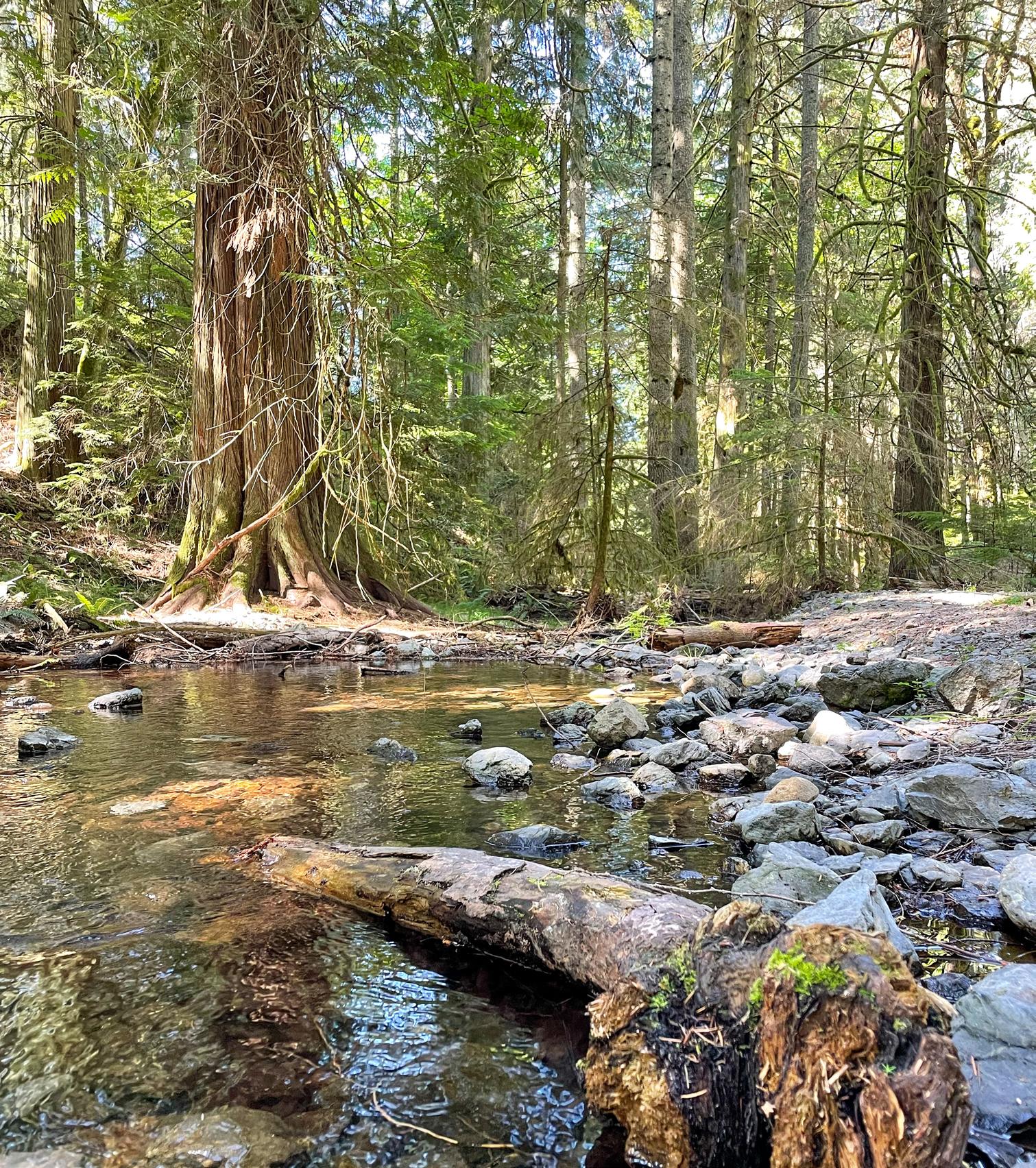
Hike the trails of Turtleback Mountain Preserve to witness the island’s diverse flora and fauna. The preserve offers multiple hiking options with varying levels of difficulty. As you explore the trails, keep an eye out for the diverse bird species and other wildlife that call
Beautiful views from the Cascade Falls Trail
the moon, the bioluminescence is too hard to see with a bright moon. If you aren’t lucky enough to visit during a dark moon, there are also sunset and full moon kayaking tours available.
Tucked away within the Rosario Resort & Spa, the Rosario Museum is a hidden gem and cultural treasure. Once the private mansion of shipbuilder and entrepreneur Robert Moran in the early 20th century, the museum now welcomes visitors to explore its rich heritage and art collection. See the private bedrooms, bathrooms and sitting areas that the family once called home. The walls are littered with photographs of the island, and Moran family from the early 20th century and showcase Moran’s love of ships. On certain days and times, you can even enjoy a concert on the grand piano in the music room.
this place home.
The most popular hiking trail in the Turtleback Mountain Preserve on Orcas Island is the “Turtleback Mountain Trail.” This trail leads to the summit of Turtleback Mountain and offers hikers breathtaking panoramic views of the San Juan Islands, the Salish Sea, and the surrounding mountains. The trail is approximately 3.5 miles round trip and provides a moderately challenging yet rewarding hiking experience.
Experience the island’s magical bioluminescence phenomenon by taking a guided kayak tour after sunset. Paddle through the sparkling waters as tiny bioluminescent organisms create an otherworldly light show. It’s a truly surreal experience that will leave you in awe of nature’s wonders.
There are several companies that run tours but tours take place during the dark phases of
Stretching from Deer Harbor on the west side of the island to Doe Bay on the east side of the island, this scenic byway winds through some of the most scenic farmlands, seascapes and tucked away hamlets on the island. The drive takes around 2-3 hours to completelonger depending on time spent at each stop. It’s a great way to get acquainted with the island.
During a very low tide, Indian Island, which is normally surrounded by water, becomes accessible via a “tombolo” – a raised trail that is uncovered by ebbing water. Low tide is also a great time to explore the many tide pools around the island. The ones on the beach of Obstruction Pass State Park are exceptionally good! We saw so many sea stars, crabs, and anemones there during low tide.
No matter how you choose to spend your time, Orcas Island is a perfect blend of kicked-back island vibes and Pacific Northwest adventure. So, pack your bags and enjoy the magic of Orcas Island!

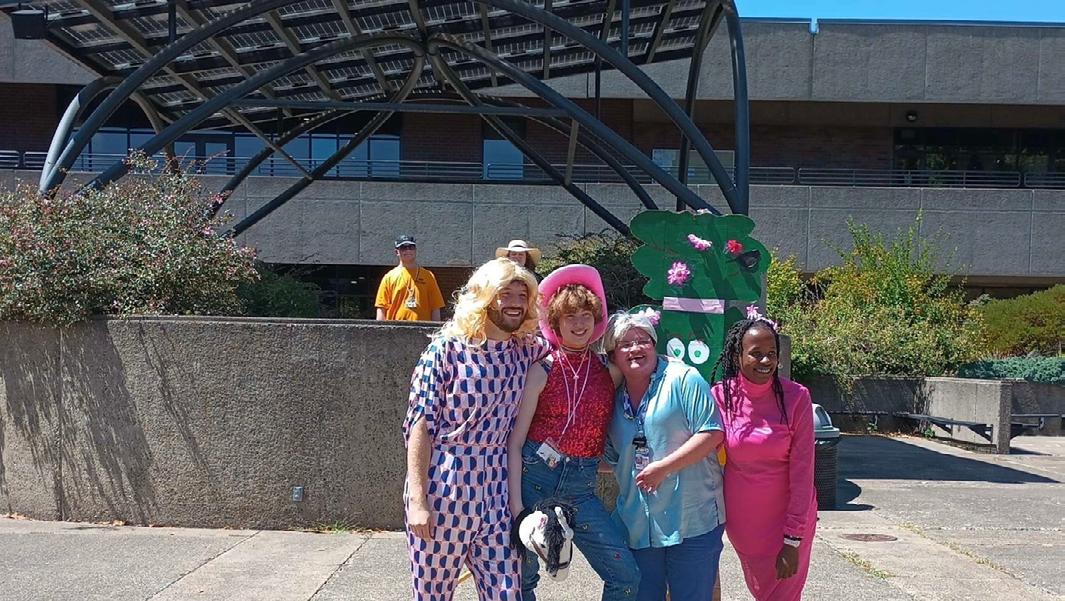

If you had summer classes, you may have noticed a swarm of children hanging out in the Courtyard this summer because we just ended our 5 weeks of summer camps for local middle and high school students. We hosted over 320 students this year! We offered welding, potato launching, ROV, short story writing, gardening, art, basketball, outdoor games, and more. Plus, we offered the Kids for Culture camp for BIPOC children in the area. The campers had a blast trying out new things, participating in talent shows, and dressing up for the theme days. Our hope is to be able to offer more exciting camps next year, so check out this website for updates next Spring.

Avery Jade is a Student Art Gallery Coordinator at the LBCC Art Gallery working on their biggest project to date, a series of portraits of local Transgender people. In this interview we discuss Avery's background as an artist as well as the meaning and inspiration behind their project.
What are you studying at LBCC?
I’m majoring in journalism and mass communications and minoring in anthropology. Originally, I was not going to minor in anthropology, I was planning on minoring in Spanish because I’m bilingual and wanted it on my diploma. I started in journalism, funny enough because my great grandfather said that I would be a good journalist. I barely knew him, but as it turns out, I really like it because I’m like a truth seeker and I really enjoy writing and I think I’m pretty good at it. And anthropology mainly because I had a really good anthropology professor, Lauren Visconti, and she inspired me to minor in it.
What is anthropology?
To break it down, Anthro means human, and Ology means study of. So it’s the study of people which is just everything and anything that has to do with people. There are like, you know, subsections like studying language, studying bones, monkeys and all of that, and I find language really interesting.
How’d you get involved with the whole art scene on campus?
It was when I first met Anne Magratten when I attended a Gender & Sexuality Alliance meeting. I really liked her. She’s an incredible person. I met her and I was like, wow, this is a really cool person. And then I didn’t really think of it until Rob Camp mentioned that there was a job in the art gallery that I could apply for. I was like oh my god, that’s really exciting because it was for student gallery coordinator. I got the job last September and have been accepted to staying on for the next year, which is really exciting. Just getting to know her through the art gallery job, she’s very much inspired me to do more with my art. She’s just such a sweet person.
So what do you do at the art gallery?
I’m a student gallery coordinator. There’s like a few of them each term, and I’m one of the only ones who stayed on the full year because students kept graduating or having other life stuff. So basically, my job is just to help with exhibits that happen on the campuses of LB. We just help plan things. We help, for instance, with the student and the faculty art shows to coordinate and navigate with everybody. It can be really stressful for one or two people if it’s a large show or there’s a lot going on. And then there’s just other odds and ends that we would do like organizing the office spaces, organizing the storage spaces, organizing emails and such. It can be pretty tedious work but it’s very fun for me. I think it’s a way for me to still study art without having to take classes. There’s a lot to learn from Anne and the other folks involved.
So about your piece, when we were talking about it over email you said you’re working on the biggest, most involved project that you’ve done so far. Can you tell us a little bit about that?
Yes, a little bit of context about it; I’m very political in my work as an artist. This idea has been brewing around since like, 2017, but I haven’t had the resources for it. It’s a series of portraits of different local Transgender people. They’re pretty intimate photos in terms of the subjects, not full nudes, but they are partial nudes. I think that it’s important to show these bodies, because being Transgender can come in all different shapes and sizes. The point I’m trying to make with it is further normalizing all aspects of Transness. I think right now, it’s especially about Trans rights and all of our identities being negated
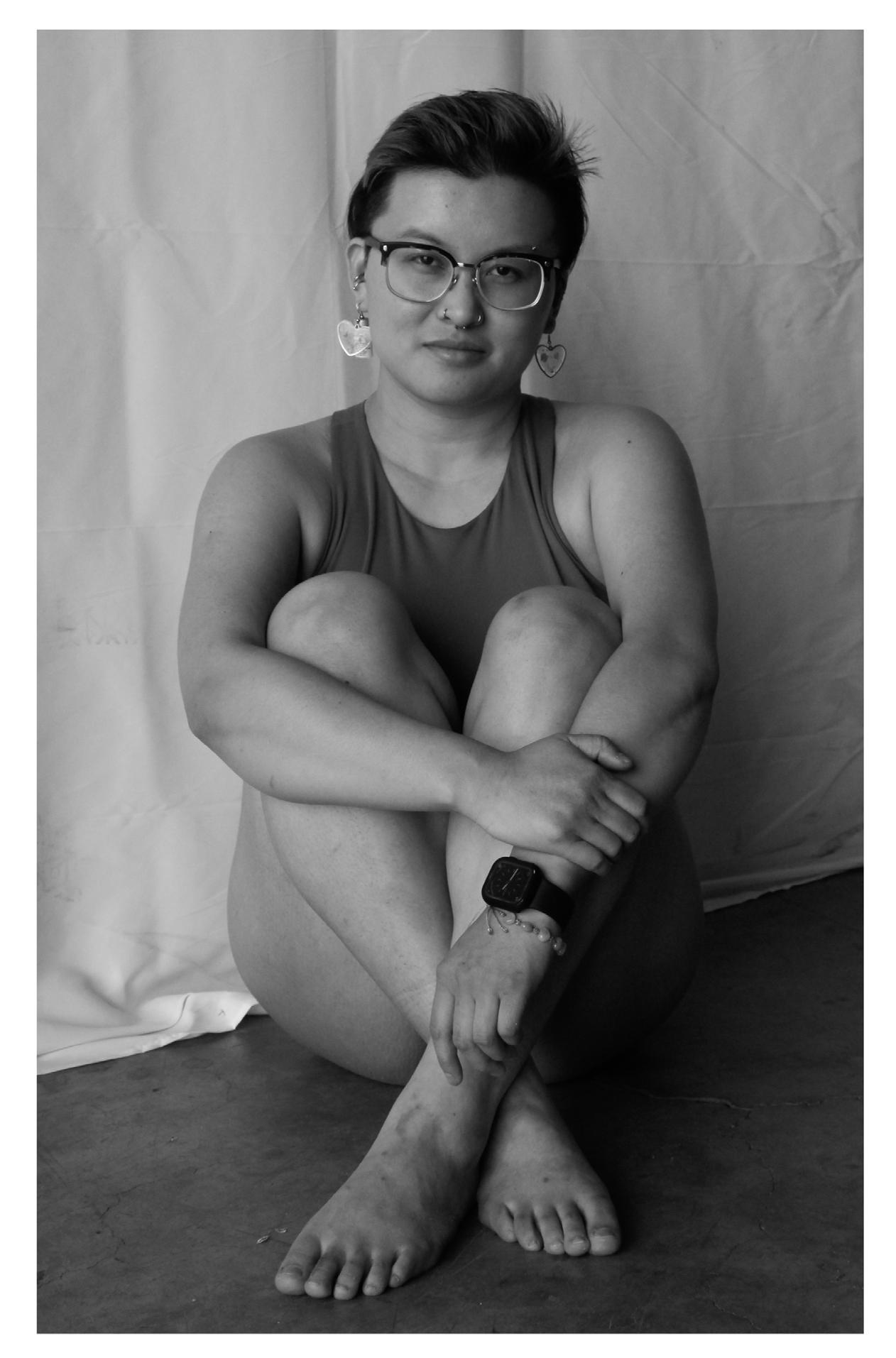
and debated for no good reason. I think it’s pretty important. It’s going to get pretty big. I think so far I have like 17 people signed on and about five full people finished. I want to finish it by the end of September, by the time I restart school, but to be honest, I think it should continue when I have the time.
Wow, that sounds like a big project. Are you going to put them in an album, or what’s the end product going to look like?
I’ve been thinking about that so much. I make zines when I can, that’s sort of my way of continuing with a form of journalism, so I am planning on doing a little photo zine that can be sold/given out. I’m not big on charging for art but a guy’s gotta make a living. After that, I’m actually planning on exhibiting it. I have an idea of doing it here on this campus possibly, but I need to discuss it with Anne still. Also hopefully at New Morning Bakery in Corvallis, which is kind of an interesting spot, and it won’t happen until fall of 2024. I am looking at some other places that are more local, but it’s primarily going to be online and in a little booklet.
What’s the inspiration behind the project?
The main inspiration is how I feel as a Transgender person and how I feel represented. I think that the purpose is to try and find a way to both normalize the experience and also kind of put a spotlight on it. Everyone expects us to have such hard lives and all, everyone always expects
us to have at least one hate crime story, which a lot of people do, but I’ve met a lot of people who have really joyous experiences with being trans. And obviously a lot of people who have not had such joyous experiences. So the purpose is kind of like showing how much there is to being Trans. I experience immense joy and have had some unchangeable experiences which haven’t all been bad thankfully. I think it should be a topic spoken about more by people who actually have the lived experience rather than people speculating. It’s pretty infuriating.
It seems like there are a lot of people out there that have strong opinions on trans rights. It would be better for everyone if people were more accepting of others. Yeah, I can’t change anyone’s mind, unfortunately I don’t have those powers. There are a lot of people who have a lot of assumptions about what being Trans looks like. A lot of the portraits I have say a big “fuck you!” to those assumptions which is entirely the point.
So were there any works or artists in particular that helped inspire the project?
Not super specifically. I am doing all black and white, which I gained a lot of inspiration from one of my favorite photographers, Claude Cahun, who was a non binary lesbian French surrealist photographer. Incredible work. They worked with the political Dadaist movement during the ‘20s and made some really fascinating collages. They captured silliness well but made it very fascinating. They revolutionized a lot of ideas with collage and surrealism, as well as queer photography in the ‘20s when it was illegal for trans and queer people to exist. Another artist, Catherine Opie, does mainly self portraits and a lot of very intimate stories with her photos which feature her life living in a queer fat body which really inspires me also.
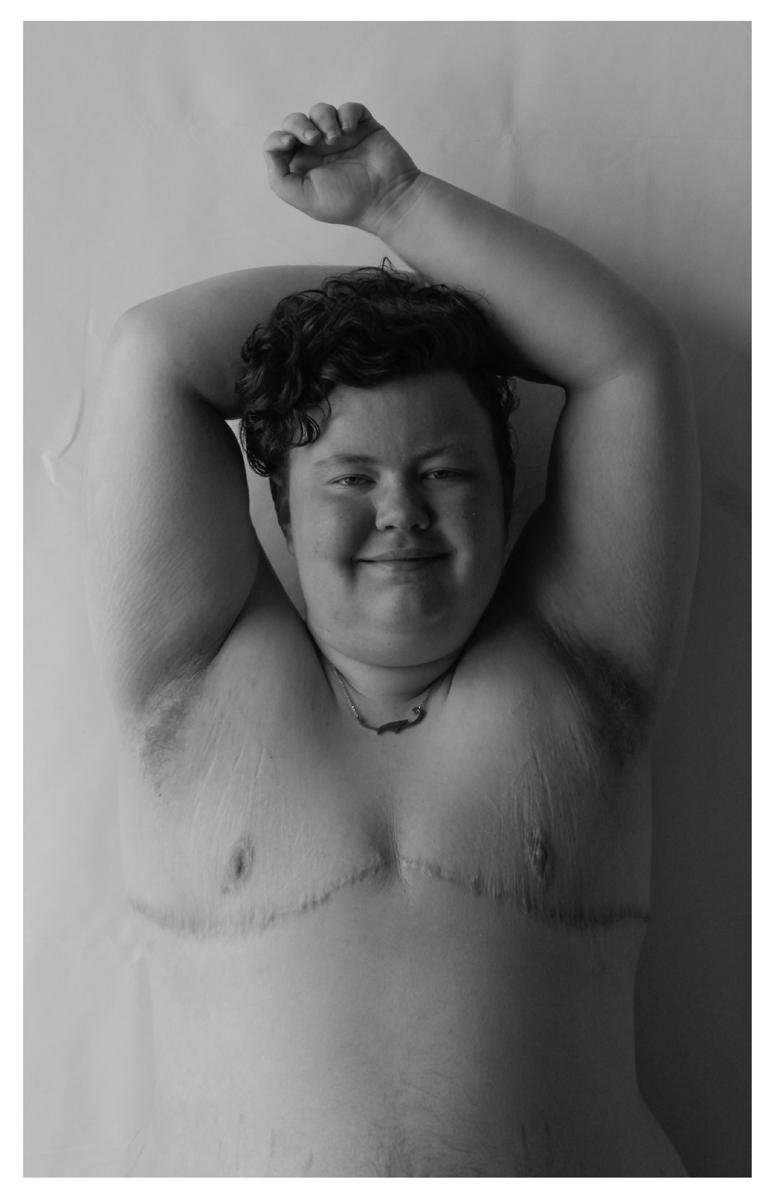

You said you’ve been thinking about the project since 2017. Has your vision for the project changed since your initial thought of doing this?
Yes. Originally, I had wanted it to be a very stark contrast. So big bright lighting on one end and really dramatic shading on another side, if that makes sense. But it’s sort of changed due to not having access to that type of lighting, but I think that having softer light translates to a softer subject. Still in your face but peaceful. I think a few other really minute details like how I would show it have really changed throughout. Considering if I would show them with a short description of the person, or if I would show them alone. I’m considering showing them with either short poems, or just a single word.
Considering if I would title them, which so far I don’t want to title them. Just leave them alone. I really hate labeling art. I just want something that makes people want to look at them, make them feel curious about the backstory of the subject and the backstory of the project.
Can you tell us a little about the time and work you’ve put into the project so far?
There’s been so much time and effort. Manual labor, not so much luckily because for me it can be pretty easy to take photos of people, especially if they’re cool people which I’ve so far only had and only expect to have moving forward. I’ve been working on this since early June, which was pretty stressful because of finals and some big life changes, but the good thing was that it had to do with my career development so I did get paid for a little bit of the work that I did. It can be really exhausting overall though for me, things like remembering to text people or socializing, so that’s been kind of a struggle. With all that though, I feel like I am getting somewhere. This is one of the first times in my history with being an artist where I can see the end, it’s beginning to take form and I’m growing more and more excited to show folks. This interview will be sort of a sneak peek for everybody.
If you want to get in touch with Avery about their project or are interested in seeing more of their art, you can reach out to them by email at thebee.aj@gmail.com or over Instagram at @aberrydoesphotos.
Barbie (2023)
Greta Gerwig
Margot Robbie, Ryan Gosling, America Ferrera, Ariana Greenblatt, Will Farrel, Issa Rae, Kate McKinnon, Simu Liu, Kingsley Ben-Adir, Michael Cera, Emma Mackey, Ncuti Gatwa, Alexandra Shipp, Hari Neff, Scott Evans
PG-13
Without a shadow of a doubt the “kenergy” this summer is off the charts, in no small part due to the release of Greta Gerwig’s Barbie movie. Mattel’s first foray into film, it has quickly become the one of the largest successes of 2023. It stands as a hilarious and satirical journey into the pink-soaked world of Barbie.
The film centers around the titular Barbie (Margot Robbie) traveling to the real world after gaining irrepressible thoughts of death, flat feet, and cellulite. On this adventure to the real world she is unexpectedly joined by the lovelorn Ken (Ryan Gosling). Arriving at Venice Beach in Los Angeles Barbie discovers the world is not as perfect as she was expecting and for Ken it’s better than he could have imagined. While in the real world Ken learns about the patriarchy and decides to take it back to Barbie Land. Upon Barbie’s return to Barbie Land she discovers that the Kens have taken over and that she, along with a woman named Gloria (America Ferrera) and her daughter (Ariana Greenblatt), may be the only hope to return the power to the Barbies. Although it is a metacomedy it handles social commentary about gendered societal norms, both of Barbie Land and the real world, and satirizes them through exaggerated characters, like the CEO of Mattel (Will Farrel), to make them stand out more in the film. The real world and Barbie Land act as exact opposites of each other and with
that the movie talks about the negatives of both patriarchal and matriarchal societies. The casting is perfect with Margot Robbie and Ryan Gosling both fully embodying Barbie and Ken, making them feel like real, albeit unrealistic, people. The rest of the Barbies (Issa Rae, Kate McKinnon, Alexandra Shipp, Emma Mackey, Hari Nef) and the Kens (Simu Liu, Ncuti Gatwa, Kingsley Ben-Adir, Scott Evans) give amazing performances as well. Finally, America Ferrera gives a standout performance as Gloria, especially in the latter half of the movie.
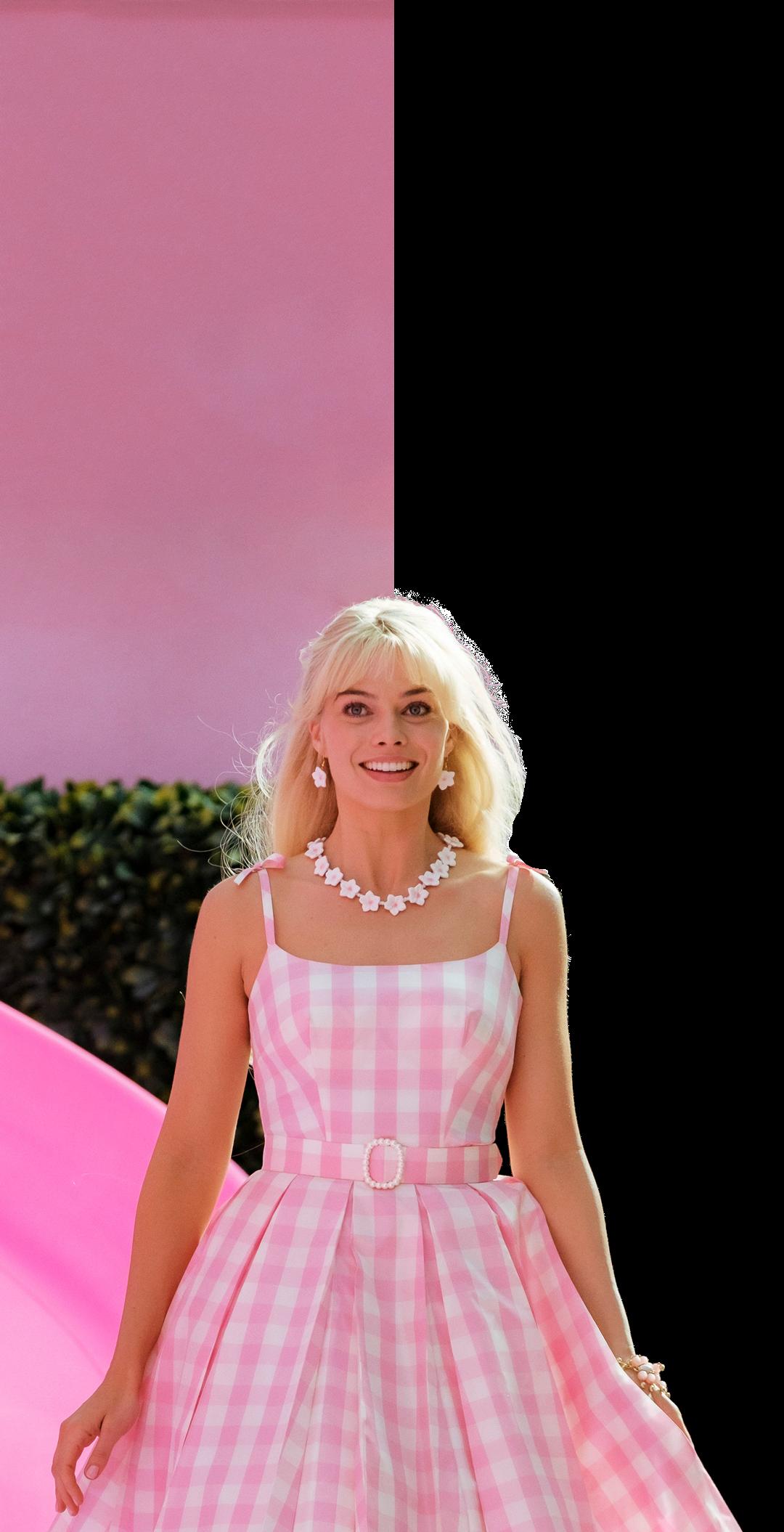
Most of the film is quite outlandish and funny, but throughout the film’s 114-minute run time there are many parts that are heartfelt and emotional. One such scene near the beginning shows Barbie sitting on a bench and observing the real world for the first time, showing the many emotions that humans can experience, which stands in stark contrast to Barbie Land.
Although the special effects may be a negative to some, to many they are a huge positive because they lean into the campiness of both the story and characters. The sets in Barbie Land look exactly like the toys, from the dream houses, to the cars, and even the animals. The costume design also takes into account the Barbie lifestyle with bright colors and actual costumes Barbie Dolls have worn in the past.
This film shows that even the most basic toys can have human and meaningful storylines while keeping the feel and tone that the toys elicit. It carries a good balance of whimsy and seriousness, with an ending that will stick with you long after you finish watching it. A smart script, amazing performances, and a perfectly executed Grease-style dance off makes Barbie a must-see movie of the summer and an unexpectedly popular blockbuster.
MOVIE: Oppenheimer (2023)
DIRECTOR: Christopher Nolan
STARRING: Cilian Murphy, Robert Downey Jr., Matt Damon, Florence Pugh and Emily Blunt with Dane DeHaan, Dave Dalmastchian and Kenneth Branagh
RATED: R
OVERALL RATING:
Oscientist Robert Oppenheimer. Coming three years after the mind-bending spy thriller the film easily ranks among the best of the year so far.

The film deals with Robert Oppenheimer (Cilian Murphy) and his involvement in the Manhattan Project, which developed the atomic bomb. The story is also framed in a nonlinear fashion, paralleling this achievement with US government hearings during the Cold War in the 1950s.
The visuals and sound are an absolute wonder to behold. Notably, the film has no CGI effects used; with each of the bomb tests and other special effects being done practically. The period sets and costumes have considerable attention to detail; and the juxtaposition of shots in color with sequences in black and white enhances the plot perfectly.
Though the film sports a runtime of 180 minutes, it certainly does not feel that way. Nolan has experience with making his films well-paced and tightly-plotted no matter the length; and this is no exception. Murphy compliments a talented supporting cast that features the likes of Robert Downey Jr., Matt Damon, Florence Pugh and Emily Blunt. Nolan had previously dealt with a WWII
Welcome Day is approaching! J O I N O U R C A M P U S C O M M U N I
Y A T W E L C O M E D A Y
O N W E D N E S D A Y , S E P T E M B E R 2 0 T H
F R O M 1 0 - 1 .
T h e S t u d e n t L e a d e r s h i p C o u n c i l w i l l b e h a v i n g a S t u d e n t
T a k e o v e r w i t h a f r e e p h o t o b o o t h , p u l l e d p o r k B B Q m e a l , m u s i c , o u t d o o r g a m e s , a n d a c a r i c a t u r e a r t i s t !
A r e y o u a c o r n h o l e f a n a t i c ? J o i n o u r c o r n h o l e t o u r n a m e n t
a t t h e S t u d e n t T a k e o v e r o n 9 / 2 0 / 2 3 . S t a r t i n
Have you downloaded the student app yet?

Download LBLive today to add your schedule and connect with peers!

